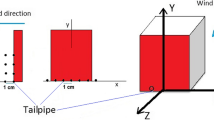Abstract
The health risks presented by noxious vehicle emissions inside tunnels has been amplified due to the increasing use of roadway tunnels. Particularly, for adjacent roadway tunnels, vehicular emissions from the upstream tunnel can further deteriorate the air quality within the following tunnels. A scale vehicle tunnel model was designed to experimentally modelled the airflow and pollutants dispersion in contiguous roadway tunnels. The channelling effect on pollutants dispersion between adjacent roadway tunnels was studied, and factors such as ventilation speed, open road section length, traffic condition (e.g. car free, car running and traffic congestion) were considered. Pollutants mass flow rate ratio between downstream and upstream tunnels was calculated to evaluate the variation of the entrained pollutants amount. For the car free condition, pollutant can be easily entrained into the downwind tunnel when the gap distance between roadway tunnels decreased. For the car running condition with fixed tunnel gap distance, the traffic speed variation barely changed the pollutants mass flow rate ratio. Furthermore, evident influences on pollutants concentration were observed from continuous congestion and partial congestion. Lastly, numerical simulation using computational fluid dynamics approach was conducted for the car free scenario, and reasonably good agreements were found for pollutants concentration ratio compared with the experimental data. The results yielded from this study further quantified the relationships among different influential factors on the pollutants dispersion between roadway tunnels, and can contribute to an improved tunnel ventilation system design, especially for the downstream tunnel.








Similar content being viewed by others
References
Ashrafi K, Shafie-pour M, Kalhor M, Esfahanian V (2012) Numerical simulation of air pollutant distribution in urban tunnels. Environ Model Assess 17(5):555–564
Athadkar M, Desai SS (2014) Importance of the extent of far-field boundaries and of the grid topology in the CFD simulation of external flows. Int J Mech Prod Eng 2(9):69–72
Bari S, Naser J (2010) Simulation of airflow and pollution levels caused by severe traffic jam in a road tunnel. Tunn Undergr Space Technol 25(1):70–77
Brousse B, Vidal B, Ponticq X, Goupil G, Alary R (2005) Pollution dispersion at an urban motorway tunnel portal: comparison of the small-scale predictive study with the actual conditions measured on the site. Atmos Environ 39(13):2459–2473
Chen TY, Lee YT, Hsu CC (1998) Investigations of piston-effect and jet fan-effect in model vehicule tunnels. J Wind Eng Ind Aerodyn 73:99–110
Chen KS, Chung C-Y, Wang SW (2002) Measurement and three-dimensional modeling of airflow and pollutant dispersion in an undersea traffic tunnel. J Air Waste Manag Assoc 52(3):349–363
Chung C-Y, Chung P-L (2007) A numerical and experimental study of pollutant dispersion in a traffic tunnel. Environ Monit Assess 130(1–3):289–299
Chung CY, Chung PL, Chen KS (2002) Modeling air pollution in a road tunnel. J Chin Inst Environ Eng 12(3):227–234
Defre R, Bruynseraede P, Kretzschmar JG (1994) Air-pollution measurements in traffic tunnels. Environ Health Perspect 102:31–37
Eftekharian E, Dastan A, Abouali O, Meigolinedjad J, Ahmadi G (2014) A numerical investigation into the performance of two types of jet fans in ventilation of an urban tunnel under traffic jam condition. Tunn Undergr Space Technol 44:56–67
Fu C, Uddin M, Curley A (2016) Insights derived from CFD studies on the evolution of planar wall jets. Eng Appl Comput Fluid Mech 10(1):44–56
Hirtl M (2011) Modelling tunnel jet emissions with LASAT: evaluation study with two Austrian data sets (Ehrentalerbergtunnel and Kaisermühlentunnel). Meteor Z 20(1):7–17
Matsumoto K, Sakai K, Horiuchi K, Takahashi H, Okamoto S (1998) Advanced air quality simulation model for road tunnel portals in complex terrain. Int J Veh Des 20(1–4):71–78
Na KS (2006) Determination of VOC source signature of vehicle exhaust in a traffic tunnel. J Environ Manag 81(4):392–398
Nasr A, Lai SJC (1998) A turbulent plane offset jet with small offset ratio. Exp Fluids 24(1):47–57
Oettl D, Sturm PJ, Bacher M, Pretterhofer G, Almbauer RA (2002) A simple model for the dispersion of pollutants from a road tunnel portal. Atmos Environ 36(18):2943–2953
Oettl D, Sturm P, Almbauer R, Okamoto S, Horiuchi K (2003) Dispersion from road tunnel portals: comparison of two different modelling approaches. Atmos Environ 37(37):5165–5175
Wang F, Wang M, He S, Zhang J, Deng Y (2010) Computational study of effects of jet fans on the ventilation of a highway curved tunnel. Tunn Undergr Space Technol 25(4):382–390
Acknowledgements
The financial supports of the Natural Science Foundation of China (Grant No. 21277080), and Chongqing Postdoctoral Research Project (Xm201331) are gratefully acknowledged. Yao Tao also especially thanks for the scholarship provided by China Scholarship Council (CSC Student ID: 201406050021).
Author information
Authors and Affiliations
Corresponding author
Additional information
Editorial responsibility: Necip Atar.
Rights and permissions
About this article
Cite this article
Tao, Y., Dong, J., Pan, X. et al. Investigation of the channelling effect on pollutants dispersion between adjacent roadway tunnels. Int. J. Environ. Sci. Technol. 14, 2733–2744 (2017). https://doi.org/10.1007/s13762-017-1355-6
Received:
Revised:
Accepted:
Published:
Issue Date:
DOI: https://doi.org/10.1007/s13762-017-1355-6




